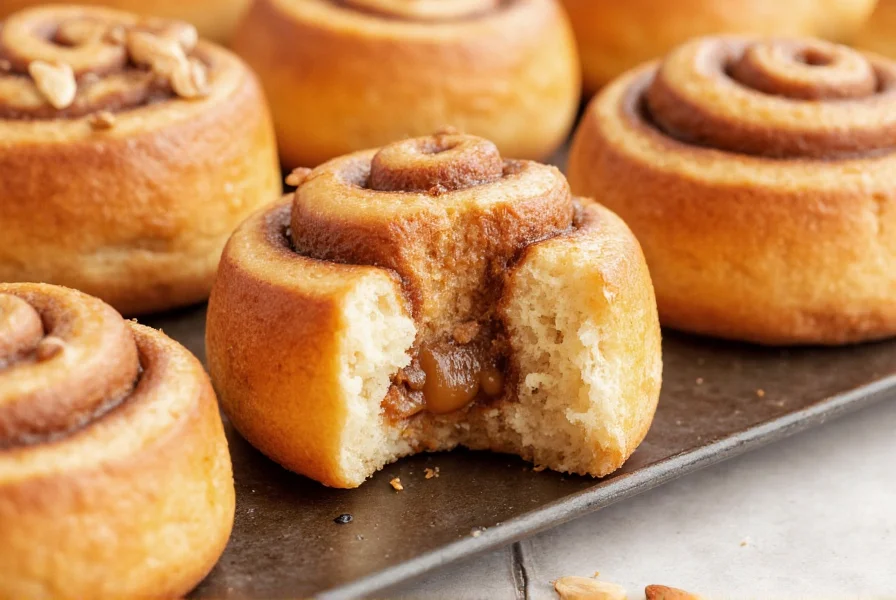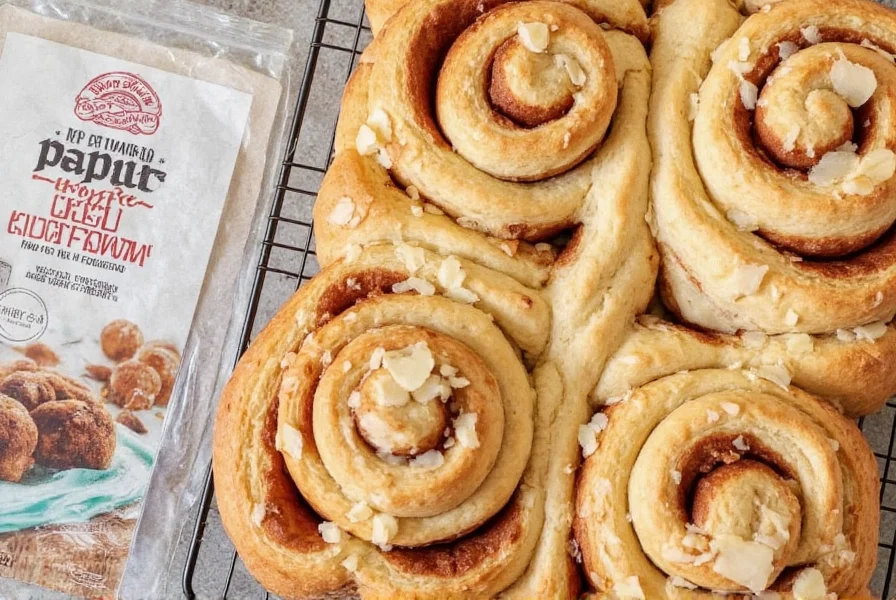Creating perfect almond flour cinnamon rolls requires understanding the unique properties of almond flour compared to traditional wheat flour. Unlike all-purpose flour, almond flour lacks gluten, which provides structure in baked goods. This means almond flour cinnamon rolls need additional binders like eggs and careful moisture management to achieve that ideal soft, pull-apart texture everyone loves in cinnamon rolls.
The Science Behind Almond Flour Baking
Almond flour behaves differently than wheat flour due to its high fat content (about 50%) and lack of starch. When making cinnamon rolls, this presents both challenges and opportunities. The natural oils in almond flour create a tender crumb, but without proper technique, your rolls may spread too much or become greasy.
Professional bakers recommend using blanched almond flour (with skins removed) for the finest texture in cinnamon rolls. The particle size matters significantly—finely ground flour yields better results than coarsely ground varieties. For optimal structure, most successful almond flour cinnamon roll recipes include:
- Eggs as primary binders (typically 2-3 per recipe)
- Tapioca or arrowroot starch (15-20% of flour weight)
- Psyllium husk powder (1-2 teaspoons) for elasticity
- Proper chilling of dough before baking
| Flour Type | Protein Content | Best For Cinnamon Rolls? | Texture Result |
|---|---|---|---|
| Blanched Almond Flour | 21g per cup | ★★★★★ | Soft, slightly dense |
| Almond Meal | 21g per cup | ★☆☆☆☆ | Gritty, uneven |
| All-Purpose Flour | 9-11g per cup | N/A | Traditional pull-apart |
Step-by-Step Almond Flour Cinnamon Roll Recipe
Follow these professional-tested steps for bakery-quality almond flour cinnamon rolls at home:
- Prepare the dough: Whisk together 2 cups blanched almond flour, 3 tablespoons tapioca starch, 1 teaspoon psyllium husk powder, 1 teaspoon baking powder, and ¼ teaspoon salt.
- Mix wet ingredients: In separate bowl, beat 3 large eggs, ¼ cup melted coconut oil, 2 tablespoons maple syrup (or sugar-free alternative), and 1 teaspoon vanilla extract.
- Combine: Gradually incorporate dry ingredients into wet mixture until a soft dough forms. Avoid overmixing.
- Chill: Refrigerate dough for 30 minutes to firm up.
- Roll out: Between parchment paper, roll dough to ¼-inch thickness (almond flour dough won't stretch like wheat dough).
Troubleshooting Common Almond Flour Cinnamon Roll Issues
Even experienced bakers encounter challenges with almond flour baking. Here's how to solve the most frequent problems:
Dry or Crumbly Rolls
This occurs when moisture balance is off. Almond flour absorbs liquid differently than wheat flour. Fix this by:
- Adding an extra egg yolk to your dough
- Increasing wet ingredients by 10-15%
- Ensuring proper chilling time before baking
- Using a kitchen scale for precise measurements (almond flour compacts differently when scooped)
Rolls That Spread Too Much
Almond flour's high fat content causes spreading. Prevent this by:
- Chilling shaped rolls for 15 minutes before baking
- Using parchment paper instead of greasing pans
- Adding 1-2 tablespoons additional almond flour if dough feels too soft
- Baking at 325°F instead of higher temperatures
Nutritional Benefits and Dietary Considerations
Almond flour cinnamon rolls offer significant advantages for specific dietary needs:
- Gluten-free: Naturally suitable for celiac disease or gluten sensitivity
- Keto-friendly: When made with sugar substitutes, net carbs can be under 5g per roll
- Higher protein: Contains approximately 6g protein per roll versus 2g in traditional versions
- Rich in vitamin E: Almonds provide this important antioxidant
For dairy-free almond cinnamon roll options, substitute butter with coconut oil or vegan butter alternatives. The best sugar-free cinnamon roll alternatives use monk fruit sweetener or allulose in the filling.
Storage and Reheating Instructions
Proper storage maintains texture and flavor:
- Room temperature: Store in airtight container for up to 2 days (almond flour products stale faster than wheat-based)
- Refrigerator: Keeps for 5 days; reheat in toaster oven for best texture
- Freezer: Wrap individual rolls in plastic wrap, then place in freezer bag for up to 3 months
Revive frozen almond flour cinnamon rolls by thawing at room temperature for 30 minutes, then warming in a 300°F oven for 8-10 minutes. Microwaving often makes them rubbery due to almond flour's protein structure.
Variations for Different Dietary Needs
Customize your almond flour cinnamon rolls for various preferences:
- Keto version: Replace maple syrup with 2 tablespoons powdered erythritol and 1 teaspoon vanilla stevia
- Vegan option: Use flax eggs (1 tablespoon ground flax + 3 tablespoons water per egg) and coconut oil
- Nut-free alternative: Try sunflower seed flour (blanched) with 1 tablespoon additional binder
- Protein boost: Add 1 scoop unflavored collagen peptides to dry ingredients

Why Almond Flour Works Better Than Other Gluten-Free Flours
When comparing almond flour vs regular flour in baking for cinnamon rolls, almond flour provides unique benefits that other gluten-free alternatives can't match. While coconut flour absorbs too much moisture and rice flour creates a gritty texture, almond flour's natural fats mimic the mouthfeel of traditional baked goods.
Professional pastry chefs note that almond flour cinnamon rolls develop a superior Maillard reaction during baking, creating that desirable golden-brown color and complex flavor notes. The key is maintaining the proper ratio of almond flour to starches—typically 4:1—for optimal structure without compromising the distinctive almond flavor.
Frequently Asked Questions
Can I substitute almond meal for almond flour in cinnamon rolls?
No, almond meal will create a gritty texture in cinnamon rolls. Almond meal contains skins and is coarsely ground, while blanched almond flour (skinless and finely ground) is essential for the smooth texture required in cinnamon roll dough.
Why do my almond flour cinnamon rolls fall apart when I try to slice them?
This typically happens when the dough lacks sufficient binders. Add 1-2 teaspoons of psyllium husk powder to your recipe, ensure proper chilling time (at least 30 minutes), and use a sharp serrated knife for cleaner cuts. The rolls should cool for 10 minutes before slicing.
How can I prevent my almond flour cinnamon rolls from becoming greasy?
Almond flour's high fat content can cause greasiness if not balanced properly. Reduce added fats by 15-20%, ensure your almond flour isn't rancid (store in refrigerator), and bake at 325°F rather than higher temperatures which can cause fat separation.
Are almond flour cinnamon rolls suitable for keto diets?
Yes, when made with sugar substitutes, almond flour cinnamon rolls can be keto-friendly. A single roll typically contains 3-5g net carbs compared to 30+g in traditional versions. Use erythritol or allulose instead of sugar in the filling for the lowest carb option.
What's the best way to store almond flour cinnamon rolls for freshness?
Store cooled rolls in an airtight container at room temperature for up to 48 hours. For longer storage, freeze individual rolls wrapped in plastic and placed in freezer bags. Thaw at room temperature for 30 minutes, then reheat in a 300°F oven for 8-10 minutes for best texture.











 浙公网安备
33010002000092号
浙公网安备
33010002000092号 浙B2-20120091-4
浙B2-20120091-4